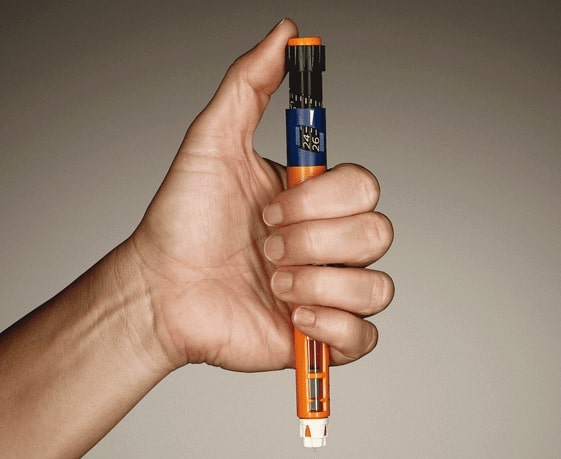Living with diabetes often requires precise and consistent management of blood sugar levels, and for many, insulin therapy is an essential part of this process. Insulin pens are a modern, convenient method for administering insulin, offering accuracy, ease of use, and flexibility compared to traditional syringes and vials. For people with diabetes—whether Type 1, Type 2, or gestational diabetes—understanding how to use an insulin pen properly can make a significant difference in their health outcomes.

This comprehensive guide will cover what insulin pens are, how to use them, when they are prescribed, and essential precautions to keep in mind. Additionally, we’ll address frequently asked questions about insulin pen use.
What Are Insulin Pens?
An insulin pen is a medical device designed to deliver insulin into the body. The device resembles a large writing pen but contains insulin inside either as a pre-filled, disposable unit or as a reusable device that holds insulin cartridges. It has a needle at one end for injection and a dial on the other for selecting the proper dose.
Insulin pens are designed to be user-friendly and offer a more accurate and discreet way of administering insulin compared to syringes and vials. They come in two main categories: disposable and reusable pens.
When Are Insulin Pens Prescribed?
Insulin pens are typically prescribed for individuals with Type 1 diabetes, as these patients need insulin to survive. They are also often recommended for those with Type 2 diabetes who cannot adequately manage their blood sugar levels with oral medications, diet, or exercise alone. Additionally, pregnant women with gestational diabetes may require insulin therapy, for which insulin pens provide a convenient delivery method.
Common reasons for prescribing insulin pens include:
Precision in dosing: Insulin pens allow users to administer accurate doses, which is critical for managing blood sugar levels.
Convenience: Pens are portable, easy to use, and often less intimidating than syringes.
Variable lifestyle needs: Some patients, such as children or older adults, may find pens easier to handle than traditional syringes.
Types of Insulin Pens
Disposable Insulin Pens
Disposable insulin pens are pre-filled with insulin and designed for one-time use. Once the insulin in the pen is depleted, the entire pen is discarded. These pens are user-friendly, requiring no assembly, making them an excellent choice for people new to insulin therapy.
Reusable Insulin Pens
Reusable pens are designed to be used multiple times with replaceable insulin cartridges. Once the cartridge is empty, it is swapped out for a new one. Reusable pens often have more sophisticated features, such as memory functions that record the date and amount of the last dose administered.
Both types of pens are widely used, but the choice depends on individual preferences, lifestyle, and medical advice.
Advantages of Insulin Pens
Using an insulin pen offers several benefits:
Ease of Use: Insulin pens are designed to simplify the process of insulin administration, making them ideal for people who may struggle with drawing insulin into a syringe from a vial.
Portability: Pens are compact and portable, allowing users to carry them discreetly for use anytime and anywhere.
Dose Accuracy: The pen’s dial system ensures precise dosing, which is especially crucial for people who require small, exact insulin doses.
Less Needle Phobia: The smaller, finer needles used with insulin pens often cause less discomfort than traditional syringe needles.
Convenient for Active Lifestyles: People with active lives can administer insulin without needing to prepare syringes or vials in public settings.
A Step-by-Step Guide to Using Insulin Pens
Proper use of an insulin pen is crucial for effective diabetes management. Follow this step-by-step guide to ensure correct administration:
Step 1: Gather Supplies
Before starting, ensure you have the following:
The insulin pen (either disposable or reusable)
A new needle for each injection
Alcohol wipes or soap and water to clean the injection site
A sharps container for needle disposal
Step 2: Prepare the Pen
For disposable pens, you just need to remove the cap. For reusable pens, ensure the insulin cartridge is correctly loaded.
Check the insulin: Look at the insulin to make sure it is the correct type and not expired. If the insulin is cloudy (as in some intermediate-acting types), gently roll the pen between your hands to mix it.
Step 3: Attach a New Needle
Remove the pen’s cap and wipe the rubber stopper with an alcohol swab.
Screwing a fresh needle onto the pen will attach it. Take off the outer needle cap and store it for disposal at a later time. Remove the inner needle cap and discard.
Step 4: Prime the Pen
Priming the pen removes air bubbles from the needle and ensures an accurate dose:
Turn the dose dial to 2 units or as directed by your healthcare provider.
With the needle pointing upward, hold the pen upright.
Press the dose button, and you should see a drop of insulin at the tip of the needle. If not, repeat the process until insulin appears.
Step 5: Select the Dose
Turn the dose dial to your prescribed dose. Ensure that the pen clicks and that the correct number is displayed on the dial.
Step 6: Choose an Injection Site
Insulin can be injected into the abdomen, thighs, buttocks, or upper arms. The abdomen is often preferred because it allows for faster absorption.
Use soap and water or an alcohol swab to clean the injection site.
Step 7: Administer the Insulin
Pinch the skin at the injection site to create a fold, especially if you are injecting into the abdomen.
Insert the needle at a 90-degree angle into the skin (for children or those with little body fat, a 45-degree angle may be preferred).
Press the button to inject the insulin. Hold the button down for 5-10 seconds to ensure the entire dose is delivered.
Step 8: Remove and Discard The Needle Carefully Disposing It
After injecting, carefully remove the needle using the outer cap you saved earlier and discard it in a sharps container.
Put the cap back on the insulin pen and store it at room temperature if in use or as per the manufacturer’s instructions if it’s not in active use.
Step 9: Rotate Injection Sites
To avoid lipodystrophy (a condition where fat deposits change due to repeated injections), rotate your injection sites regularly. For example, inject at least 1 inch away from your previous injection site each time.
Precautions When Using Insulin Pens
Using an insulin pen safely is as important as using it correctly. These are the things you need to be cautious about:
Correct Dosing
Always double-check that you’ve set the correct dose before injecting. Incorrect dosing can result in dangerously high or low blood sugar levels.
Use a New Needle for Each Injection
Reusing needles can cause contamination, infection, or needle dullness, which can make injections painful.
Store Insulin Properly
Insulin pens that are in use can usually be kept at room temperature for up to 28 days (depending on the brand). However, unopened pens should be refrigerated.
Never freeze insulin or expose it to extreme temperatures, as this can affect its potency.
Dispose of Needles Safely
It is recommended to dispose of used needles in a designated sharps container. Never throw needles directly into the trash, as they can pose a health hazard to others.
Watch for Side Effects
Be aware of potential side effects, including hypoglycemia (low blood sugar), allergic reactions, or skin irritation at the injection site. Please get in touch with your healthcare professional right away if you experience serious symptoms.
Consult Your Healthcare Provider
If you are unsure about any aspect of using your insulin pen, consult your doctor or diabetes educator.
Your insulin dose or injection schedule may need adjustments based on your activity level, diet, or blood sugar readings.
Conclusion
Insulin pens have revolutionized insulin therapy by making it more accessible, accurate, and convenient. Whether you are using a disposable or reusable pen, learning how to use the device properly is essential for effective diabetes management. By following the step-by-step instructions and taking necessary precautions, individuals with diabetes can maintain their blood sugar levels more efficiently and with greater comfort.
Insulin pens are just one part of diabetes management, and it’s essential to consult healthcare professionals for individualized advice tailored to your specific condition.
Frequently Asked Questions
Q1: How often should I change the needle on my insulin pen?
You should use a new needle for each injection. Reusing needles can lead to infections, pain, or issues with proper insulin delivery.
Q2: Can I travel with my insulin pen?
Yes, insulin pens are portable and travel-friendly. Just make sure to store them properly, and bring a doctor’s note if traveling by air, as you may need to inform security about the medical necessity of carrying insulin.
Q3: Can I inject insulin through clothing?
It is not recommended to inject insulin through clothing because it can contaminate the needle, reduce accuracy, and increase the risk of infection.
Q4: What should I do if I forget to take my insulin dose?
If you miss a dose, check your blood sugar levels and contact your healthcare provider for advice on how to proceed. Do not double your next dose unless instructed by your doctor.
Q5: How do I know when my insulin pen is empty?
For disposable pens, the dose dial will no longer turn when empty. For reusable pens, the insulin cartridge will be visibly depleted, and the dose dial will also indicate when the cartridge is finished.
Reference : http://www.webmd.com
Disclaimer : This article is for educational purposes only. Consult your medical practitioner before acting on the information provided in the article.







